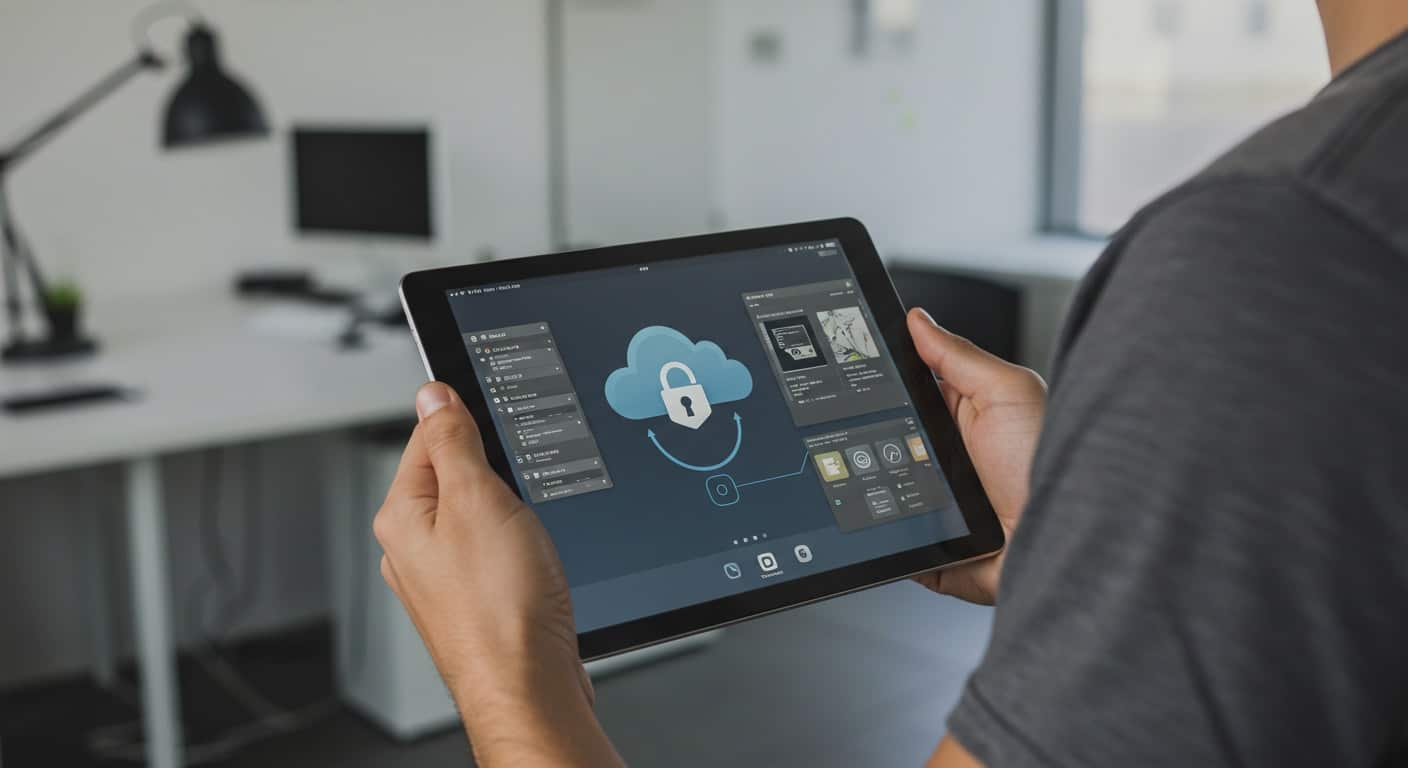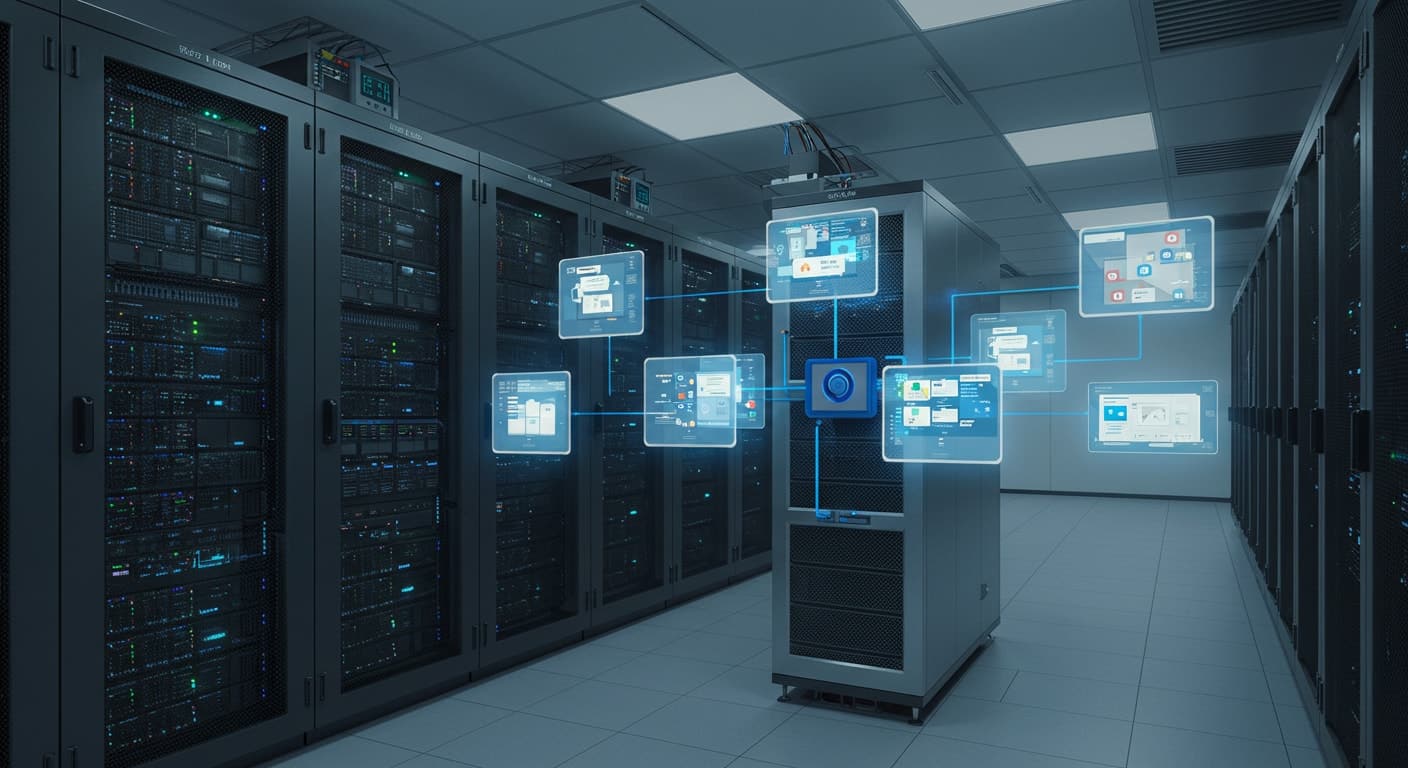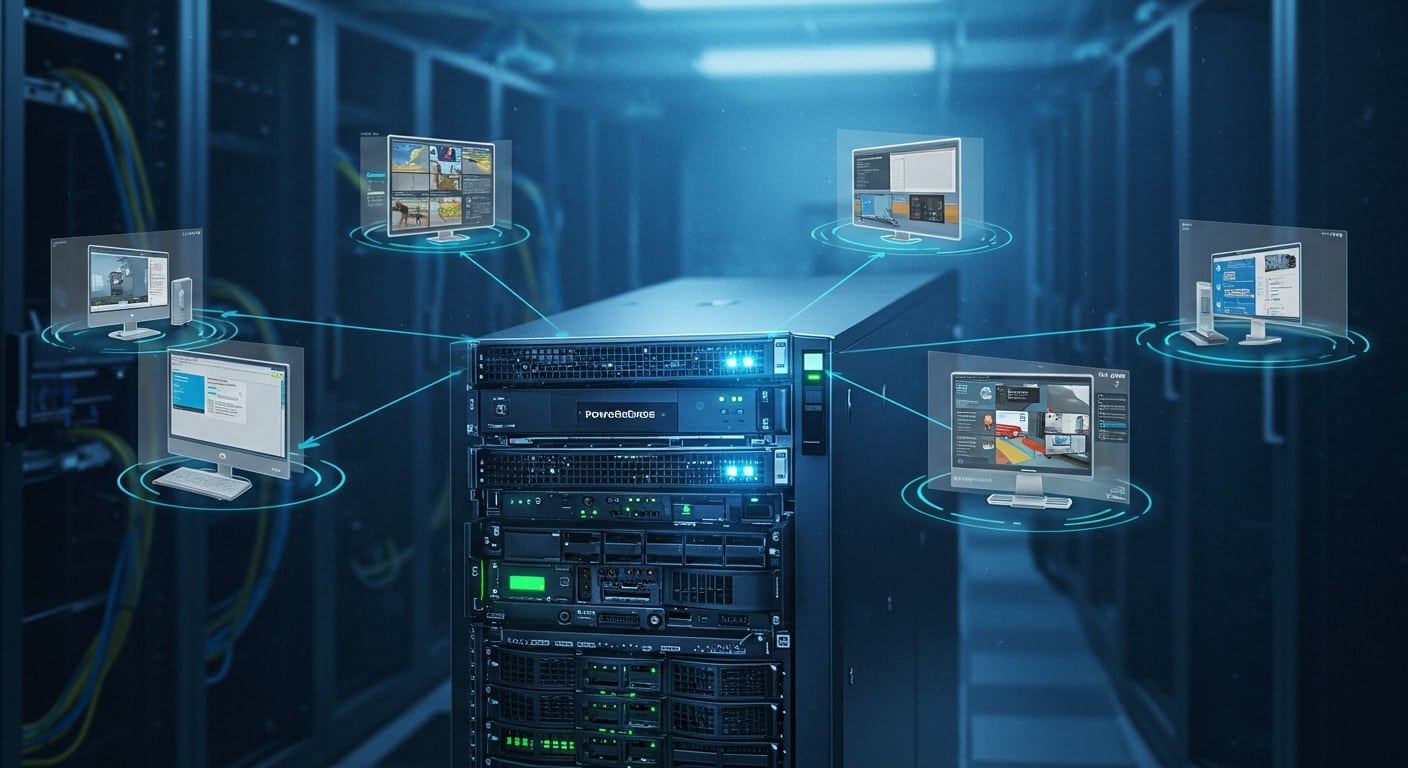You’ve likely heard of Citrix VDI, especially if you’re navigating the challenges of remote or hybrid work. But what exactly does Citrix VDI mean for you in practical terms?
Citrix VDI—or Virtual Desktop Infrastructure—is essentially technology that enables you to access your desktop remotely from virtually anywhere. Your desktop isn’t tied to one physical location but lives securely in a centralized data center.
You log in and interact with your apps and files as if you were sitting right in your office. This approach is part of a broader trend known as desktop virtualization, designed to simplify remote work and improve efficiency.
VDI’s growing importance stems from its ability to maintain productivity and security without sacrificing flexibility. Yet, there are multiple ways to achieve virtualization, some simpler than others. We’ll explore exactly how Citrix VDI works, what makes it stand out, and touch briefly on alternatives like Apporto.
1. Defining Citrix VDI in Simple Terms

What is Virtual Desktop Infrastructure (VDI)?
Virtual Desktop Infrastructure, commonly known as VDI, allows you to access your desktop remotely using practically any client device, like your laptop or tablet. Instead of your desktop environment running on your personal computer, it’s hosted within a secure, centralized data center on virtual machines.
Think of VDI as your work desktop moving from a physical device in your office to a digital space in the cloud. When you log in, you’re interacting with your usual desktop operating system, complete with your preferred settings, software, and data. This means whether you’re at home, traveling, or anywhere in-between, your desktop environment remains consistent and secure.
VDI commonly serves organizations that require employees to access secure data remotely, like healthcare providers managing patient records or educational institutions offering consistent software tools to students. In essence, VDI helps you maintain productivity and security no matter where you are.
What is Citrix VDI?
Citrix VDI specifically refers to Citrix’s approach to delivering virtual desktops and apps. Two core solutions make up this offering: Citrix Virtual Apps (formerly XenApp) and Citrix Virtual Desktops (formerly XenDesktop).
Citrix Virtual Apps delivers individual applications remotely, meaning you open only the apps you need from a server, without running an entire virtual desktop. On the other hand, Citrix Virtual Desktops gives you access to an entire desktop environment hosted remotely, complete with operating systems, applications, and personal settings.
There are two types of setups within Citrix VDI:
- Desktop-based VDI: Each user gets their own dedicated virtual desktop running on its own virtual machine.
- Server-based VDI: Multiple users share resources on a single server, each accessing an isolated desktop session.
Both methods have their advantages, depending on your organization’s needs, but each also carries complexity—something that occasionally leads users to consider simpler alternatives, like Apporto.
2. How Does Citrix VDI Work?

Virtual Machines and Desktop Operating Systems
At the core of Citrix VDI are virtual machines, often simply called VMs. Think of a VM as a virtual computer within a physical server—complete with its own operating system, software, and storage. These virtual machines host desktop operating systems, typically Windows, allowing you to interact remotely as if you were using your personal desktop.
By running multiple virtual desktops on a single physical server, virtualization technology optimizes resources and reduces hardware costs. Citrix utilizes this concept extensively, providing seamless remote desktop experiences to multiple users simultaneously, all securely isolated from each other within the same data center.
Role of Citrix XenDesktop and Citrix XenApp
Citrix VDI mainly leverages two essential components—Citrix XenDesktop (now called Citrix Virtual Desktops) and Citrix XenApp (now Citrix Virtual Apps)—to deliver virtual desktops and applications remotely. XenDesktop provides users with fully virtualized desktop environments, whereas XenApp specializes in delivering individual applications without the need to virtualize an entire desktop.
Citrix achieves this primarily through server-based hosted applications and desktops. Instead of installing software directly on user devices, applications reside on centralized servers, enabling multiple users to access these resources remotely. This centralized model simplifies management, improves security, and reduces software compatibility issues.
Deployment often relies on Citrix’s Provisioning Services, which simplify how virtual desktops and applications are delivered and managed. Administrators create standardized virtual desktop templates, which are rapidly deployed across multiple virtual machines. This ensures a consistent and streamlined experience every time you log in remotely, while administrators enjoy simplified management.
Citrix Workspace and Citrix Receiver
Citrix Workspace App, previously known as Citrix Receiver, is the main interface connecting users to Citrix VDI environments. It acts like a gateway, giving you easy access to virtual desktops and applications from various endpoint devices—whether a laptop, smartphone, thin client, or tablet.
The Workspace App ensures seamless connectivity, enabling multiple users to securely connect to their virtual desktops or specific applications simultaneously. Whether you’re accessing a full desktop or just select apps, Citrix Workspace provides a consistent, intuitive user experience.
For IT administrators, Workspace App streamlines management tasks by centralizing user access controls, security policies, and updates. This setup means fewer worries about compatibility or device-specific issues, as the application adjusts automatically to your preferred device. In essence, Citrix Workspace simplifies remote access, making virtual desktops feel like natural extensions of your usual work environment.
3. Key Features and Capabilities of Citrix VDI

Overview of Citrix Virtualization Features
Citrix VDI includes powerful virtualization features aimed at delivering efficient remote access and centralized management. At its core, Citrix leverages centralized deployment from data centers, where virtual desktops and apps reside securely on powerful physical servers. This centralized management allows IT teams to efficiently oversee and control large-scale deployments without managing individual user devices.
Additional features include advanced load balancing, ensuring optimal performance across multiple virtual machines, and robust security policies that protect data and applications. Citrix also integrates smoothly with various cloud platforms, like Microsoft Azure, offering flexible hybrid deployment options.
Citrix virtualization prioritizes scalability, letting administrators quickly deploy additional desktops or resources as needed. By centralizing everything—applications, desktops, and management—Citrix VDI aims to reduce complexity and increase productivity, especially in large organizations with diverse user needs.
Persistent VDI vs. Non-persistent VDI Desktops
Citrix offers two primary types of virtual desktops: persistent and non-persistent. Persistent VDI desktops provide a dedicated virtual desktop to each user, preserving personal settings, installed software, and data between sessions. They function much like a personal PC, offering familiarity and convenience.
Non-persistent desktops, however, reset to a standard state after each use. Any changes or files are erased once the user logs out, making this approach ideal for environments that prioritize security or standardization, such as customer support or shared workstations. Choosing between these two options usually depends on your organization’s security, personalization, and management preferences.
Citrix Provisioning Services and Premium Editions
Citrix provides multiple service tiers, including Virtual Apps Premium, Desktops Premium Edition, and Desktops Advanced. Virtual Apps Premium focuses on enhanced application delivery, while Desktops Premium Edition offers comprehensive desktop virtualization features, including powerful provisioning services for rapid desktop deployment.
Desktops Advanced strikes a balance, offering essential desktop virtualization capabilities at a lower cost. Provisioning Services streamline virtual desktop deployment, allowing IT to easily distribute consistent desktop images across an entire organization.
Remote PC Access and Mobile Device Compatibility
Another strong advantage of Citrix VDI is its support for remote PC access from virtually any device. Whether you’re using laptops, smartphones, tablets, or even thin clients, Citrix ensures a consistent user experience.
This flexibility greatly benefits remote workers who frequently switch devices or locations. By making desktops universally accessible, Citrix enhances productivity, allowing seamless transitions between home, office, and on-the-go environments without compromising security or user convenience.
4. Pros and Cons of Using Citrix VDI
| Pros of Citrix VDI | Cons of Citrix VDI |
|---|---|
| Centralized Management: Control of virtual desktops from a centralized data center. | Complex Initial Deployment: Requires significant expertise, with complicated default configurations. |
| Enhanced Security: Data remains secure within centralized servers, reducing risks of data breaches. | High Infrastructure Costs: Significant expenses involved in maintaining physical servers, hardware, and licensing. |
| Flexibility & Scalability: Integrates multiple virtual machines, supporting scalability and varied user requirements. | Dependency on Citrix Components: Relies heavily on additional tools like Citrix ADC and Citrix SD-WAN, increasing complexity. |
| Cloud Integration: Integration with platforms like Microsoft Azure for hybrid deployments. | Performance Issues: Potential latency or network performance concerns, especially in large deployments or insufficient setups. |
| Streamlined Maintenance: Centralized updates simplify administration of applications and operating systems. | Resource Intensive: Requires ongoing specialized IT support and regular staff training to maintain effectively. |
5. Comparing Citrix VDI to Alternative VDI Solutions

What are Some Citrix Alternatives?
Citrix isn’t the only player in the VDI market—other solutions like VMware Horizon (Omnissa), Microsoft Remote Desktop Services (RDS), and Azure Virtual Desktop offer competitive alternatives.
Microsoft Remote Desktop Services, commonly utilized by smaller businesses or simpler deployments, provides basic remote desktop functionality within Windows environments. Meanwhile, Azure Virtual Desktop provides robust integration with Microsoft cloud services, appealing to enterprises already deeply invested in Microsoft ecosystems.
Each platform differs in complexity, flexibility, and ease of use, reflecting various organizational needs and resources.
Introducing Apporto
If you’re looking for a straightforward alternative to traditional VDI solutions like Citrix, Apporto stands out due to its modernized approach to desktop virtualization. Rather than requiring extensive infrastructure and complex management setups, Apporto delivers virtual desktops and applications effortlessly through a fully cloud-based platform.
Apporto’s streamlined interface and simplified management make it especially attractive to organizations wanting to avoid the complexity typically associated with Citrix deployments. With Apporto, you eliminate the need for maintaining extensive server farms or intricate network setups. The result is quicker deployment, fewer administrative headaches, and increased agility.
Ideal for educational institutions, mid-sized enterprises, or any organization prioritizing ease of use, Apporto reduces the barriers to effective remote desktop solutions. If simplicity, lower overhead, and rapid deployment are essential for your team, Apporto clearly positions itself as an accessible, reliable, and intuitive alternative to the often complex Citrix virtualization ecosystem.
6. Why Choose Apporto Over Citrix VDI?

Easier Deployment and Management
Many organizations choose Apporto for its simplicity. Unlike Citrix’s complex management—requiring extensive server setups and network configurations—Apporto provides straightforward cloud-based deployment. Administering desktops and apps through an intuitive interface reduces setup times and simplifies ongoing maintenance.
Superior User Experience
Apporto ensures seamless access to virtual desktops and apps across various devices, including laptops, tablets, and smartphones. Compared to potential latency issues with Citrix Workspace, Apporto typically offers smoother interactions and faster response times, enhancing user productivity and satisfaction.
Cost-effectiveness and Clear Pricing
Apporto stands out for its transparent, predictable pricing structure. Unlike Citrix’s complicated licensing tiers and hidden costs, Apporto simplifies budgeting with straightforward pricing. This clarity is especially beneficial for smaller organizations or those managing tighter budgets.
Flexible Cloud Integration and Device Compatibility
Apporto’s cloud-native architecture simplifies integration with existing cloud platforms, eliminating the complexity often associated with Citrix deployments. Additionally, users can easily switch between different devices—desktops, tablets, or smartphones—without compatibility issues. This flexibility enhances productivity, particularly in dynamic or remote work environments.
Conclusion
Citrix VDI is undoubtedly a powerful option in the virtual desktop infrastructure market, especially if your organization requires extensive customization and centralized control. However, its complexity and cost can sometimes outweigh its benefits. That’s why it’s important to thoughtfully assess your organization’s needs first.
If simplicity, ease of use, and affordability resonate more with your situation, Apporto could be a better fit. Feel free to explore Apporto further—maybe even schedule a quick demo—to see if it’s the right choice to simplify your virtual desktop experience and make your team’s remote work smoother.


